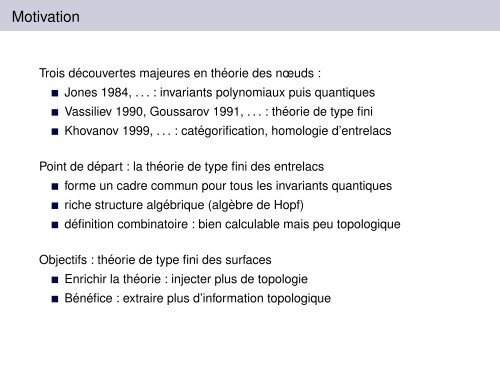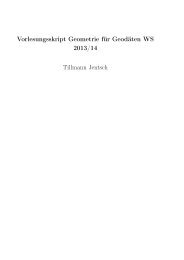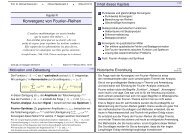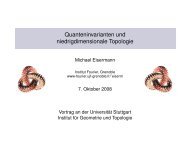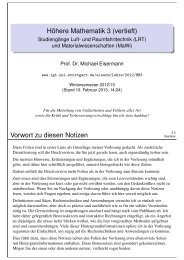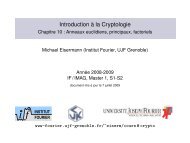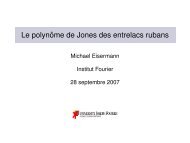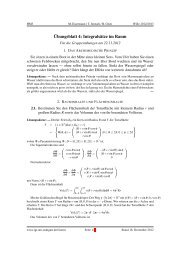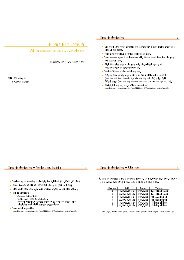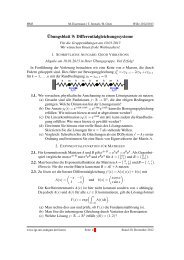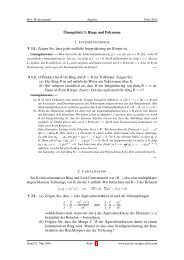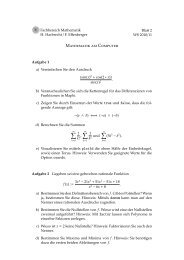- Page 1 and 2: Invariants de type fini de surfaces
- Page 3 and 4: Motivation Trois découvertes majeu
- Page 5 and 6: Motivation Trois découvertes majeu
- Page 7 and 8: Motivation Trois découvertes majeu
- Page 9 and 10: Motivation Trois découvertes majeu
- Page 11: Motivation Trois découvertes majeu
- Page 15 and 16: Plan de l’exposé 1 Invariants de
- Page 17 and 18: Nœuds et entrelacs Un nœud est un
- Page 19 and 20: Exemple : le nombre d’enlacement
- Page 21 and 22: Exemple : le nombre d’enlacement
- Page 23 and 24: Invariants d’entrelacs de type fi
- Page 25 and 26: Invariants d’entrelacs de type fi
- Page 27 and 28: Invariants d’entrelacs de type fi
- Page 29 and 30: Invariants d’entrelacs de type fi
- Page 31 and 32: Invariants d’entrelacs de type fi
- Page 33 and 34: Invariants d’entrelacs qui ne son
- Page 35 and 36: Invariants d’entrelacs qui ne son
- Page 37 and 38: Surfaces de Seifert Théorème (Sei
- Page 39 and 40: Surfaces de Seifert Théorème (Sei
- Page 41 and 42: Surfaces de Seifert Théorème (Sei
- Page 43 and 44: Invariants de surfaces de type fini
- Page 45 and 46: Invariants de surfaces de type fini
- Page 47 and 48: Invariants de surfaces de type fini
- Page 49 and 50: Invariants de surfaces de type fini
- Page 51 and 52: Invariants de type fini Proposition
- Page 53 and 54: Invariants de type fini Proposition
- Page 55 and 56: Invariants de type fini Proposition
- Page 57 and 58: Forme de Seifert et déterminant So
- Page 59 and 60: Forme de Seifert et déterminant So
- Page 61 and 62: Forme de Seifert et déterminant So
- Page 63 and 64:
Forme de Seifert et déterminant So
- Page 65 and 66:
Forme de Seifert et déterminant So
- Page 67 and 68:
Singularités de surfaces dans R 4
- Page 69 and 70:
Singularités de surfaces dans R 4
- Page 71 and 72:
Singularités de surfaces dans R 4
- Page 73 and 74:
Singularités de surfaces dans R 4
- Page 75 and 76:
Singularités de surfaces dans R 4
- Page 77 and 78:
Singularités de surfaces dans R 4
- Page 79 and 80:
Surfaces plongées et immergées da
- Page 81 and 82:
Surfaces rubans (Fox 1962) Définit
- Page 83 and 84:
Surfaces rubans (Fox 1962) Définit
- Page 85 and 86:
Surfaces rubans (Fox 1962) Définit
- Page 87 and 88:
Surfaces rubans (Fox 1962) Définit
- Page 89 and 90:
Le problème « slice ⇒ ribbon »
- Page 91 and 92:
Le problème « slice ⇒ ribbon »
- Page 93 and 94:
Le problème « slice ⇒ ribbon »
- Page 95 and 96:
Le problème « slice ⇒ ribbon »
- Page 97 and 98:
Polynôme de Jones : définition Th
- Page 99 and 100:
Polynôme de Jones : définition Th
- Page 101 and 102:
Polynôme de Jones : définition Th
- Page 103 and 104:
Une propriété d’integralité du
- Page 105 and 106:
Une propriété d’integralité du
- Page 107 and 108:
Une propriété d’integralité du
- Page 109 and 110:
La nullité du polynôme de Jones D
- Page 111 and 112:
La nullité du polynôme de Jones D
- Page 113 and 114:
La nullité du polynôme de Jones D
- Page 115 and 116:
Congruences fines Théorème [G&T 2
- Page 117 and 118:
Congruences fines Théorème [G&T 2
- Page 119 and 120:
Congruences fines Théorème [G&T 2
- Page 121 and 122:
Congruences fines Théorème [G&T 2
- Page 123 and 124:
La congruence modulo 32 est optimal
- Page 125 and 126:
La congruence modulo 32 est optimal
- Page 127 and 128:
Développement du polynôme de Jone
- Page 129 and 130:
Développement du polynôme de Jone
- Page 131 and 132:
Développement du polynôme de Jone
- Page 133 and 134:
Développement du polynôme de Jone
- Page 135 and 136:
Développement de la signature en u
- Page 137 and 138:
Développement de la signature en u
- Page 139 and 140:
Développement de la signature en u
- Page 141 and 142:
Développement de la signature en u
- Page 143 and 144:
La catégorie des surfaces plongée
- Page 145 and 146:
La catégorie des surfaces plongée
- Page 147 and 148:
Relations imposées par l’isotopi
- Page 149 and 150:
Relations imposées par l’isotopi
- Page 151 and 152:
Relations imposées par l’isotopi
- Page 153 and 154:
Relations imposées par l’isotopi
- Page 155 and 156:
Relations imposées par l’isotopi
- Page 157 and 158:
Relations imposées par l’isotopi
- Page 159 and 160:
La catégorie des surfaces abstrait
- Page 161 and 162:
La catégorie des surfaces abstrait
- Page 163 and 164:
Diagrammes en arcs Filtration I-adi
- Page 165 and 166:
Diagrammes en arcs Filtration I-adi
- Page 167 and 168:
Diagrammes en arcs Filtration I-adi
- Page 169 and 170:
Vers un invariant universel On souh
- Page 171 and 172:
Vers un invariant universel On souh
- Page 173 and 174:
Plan de l’exposé 1 Invariants de
- Page 175 and 176:
Questions ouvertes Polynôme de Jon
- Page 177 and 178:
Questions ouvertes Polynôme de Jon
- Page 179 and 180:
Questions ouvertes Polynôme de Jon
- Page 181 and 182:
Questions ouvertes Polynôme de Jon
- Page 183 and 184:
Questions ouvertes Polynôme de Jon
- Page 185 and 186:
Plan de l’exposé 5 Appendice : l
- Page 187 and 188:
Surfaces rubans et diagrammes ruban
- Page 189 and 190:
Surfaces rubans et diagrammes ruban
- Page 191 and 192:
Le crochet de Kauffman Définition
- Page 193 and 194:
Le crochet de Kauffman Définition
- Page 195 and 196:
La nullité de Jones : borne infér
- Page 197 and 198:
La nullité de Jones : borne infér
- Page 199 and 200:
La nullité de Jones : borne infér
- Page 201 and 202:
La nullité de Jones : borne infér
- Page 203 and 204:
Invariants de type fini de surfaces
- Page 205 and 206:
Invariants de type fini de surfaces
- Page 207 and 208:
Invariants de type fini de surfaces
- Page 209 and 210:
Invariants de type fini de surfaces


